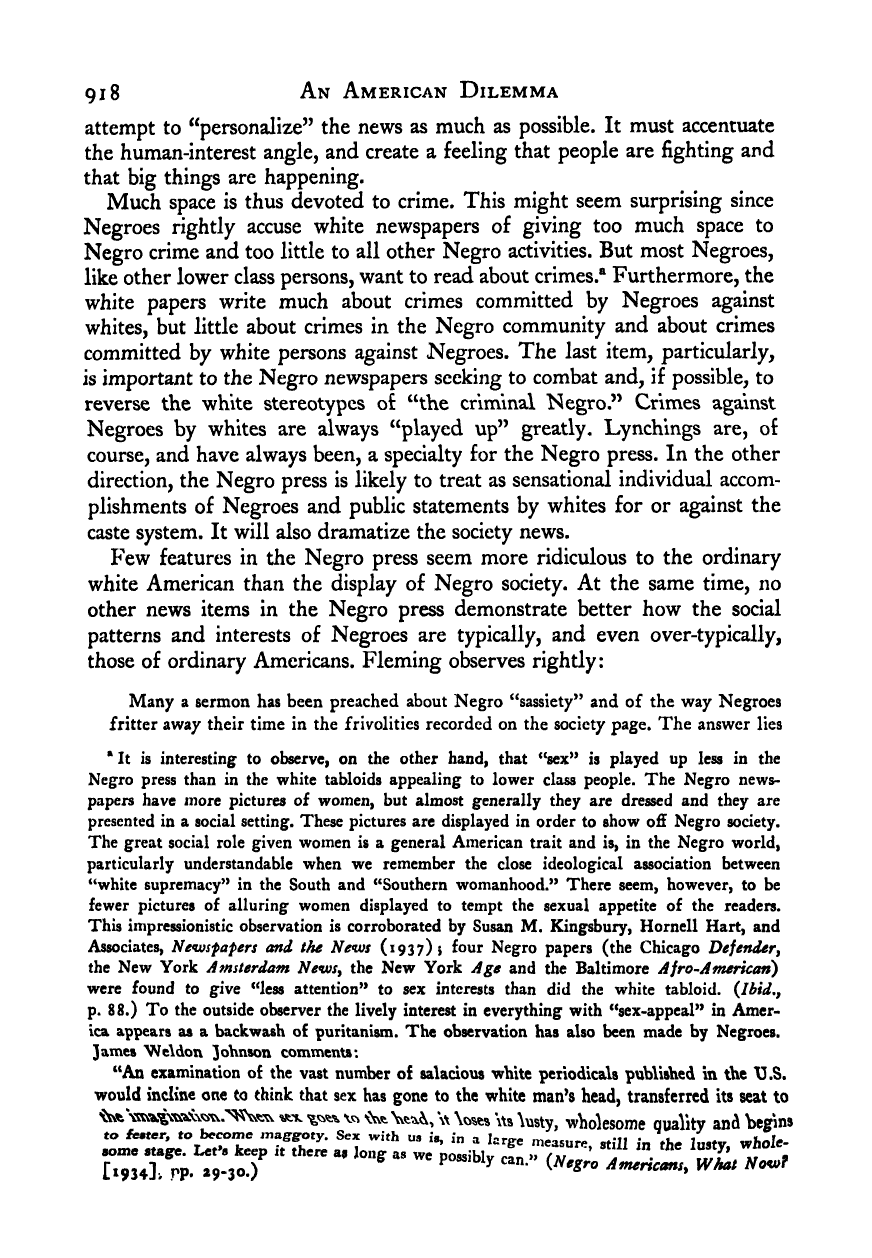Note: Gunnar Myrdal died in 1987, less than 70 years ago. Therefore, this work is protected by copyright, restricting your legal rights to reproduce it. However, you are welcome to view it on screen, as you do now. Read more about copyright.
Full resolution (TIFF) - On this page / på denna sida - IX. Leadership and Concerted Action - 42. The Negro Press - 3. Characteristics of the Negro Press

<< prev. page << föreg. sida << >> nästa sida >> next page >>
Below is the raw OCR text
from the above scanned image.
Do you see an error? Proofread the page now!
Här nedan syns maskintolkade texten från faksimilbilden ovan.
Ser du något fel? Korrekturläs sidan nu!
This page has never been proofread. / Denna sida har aldrig korrekturlästs.
91 8 An American Dilemma
attempt to ^‘personalize” the news as much as possible. It must accentuate
the human-interest angle, and create a feeling that people are fighting and
that big things are happening.
Much space is thus devoted to crime. This might seem surprising since
Negroes rightly accuse white newspapers of giving too much space to
Negro crime and too little to all other Negro activities. But most Negroes,
like other lower class persons, want to read about crimes.^ Furthermore, the
white papers write much about crimes committed by Negroes against
whites, but little about crimes in the Negro community and about crimes
committed by white persons against Negroes. The last item, particularly,
is important to the Negro newspapers seeking to combat and, if possible, to
reverse the white stereotypes of “the criminal Negro.” Crimes against
Negroes by whites are always “played up” greatly. Lynchings are, of
course, and have always been, a specialty for the Negro press. In the other
direction, the Negro press is likely to treat as sensational individual accom-
plishments of Negroes and public statements by whites for or against the
caste system. It will also dramatize the society news.
Few features in the Negro press seem more ridiculous to the ordinary
white American than the display of Negro society. At the same time, no
other news items in the Negro press demonstrate better how the social
patterns and interests of Negroes are typically, and even over-typically,
those of ordinary Americans. Fleming observes rightly:
Many a sermon has been preached about Negro “sassiety’’ and of the way Negroes
fritter away their time in the frivolities recorded on the society page. The answer lies
* It is interesting to observe, on the other hand, that *^sex’’ is played up less in the
Negro press than in the white tabloids appealing to lower class people. The Negro news-
papers have more pictures of women, but almost generally they are dressed and they are
presented in a social setting. These pictures are displayed in order to show off Negro society.
The great social role given women is a general American trait and is, in the Negro world,
particularly understandable when we remember the close ideological association between
“white supremacy” in the South and “Southern womanhood.” There seem, however, to be
fewer pictures of alluring women displayed to tempt the sexual appetite of the readers.
This impressionistic observation is corroborated by Susan M. Kingsbury, Hornell Hart, and
Associates, Ne^wsfafers and the News (1937)5 four Negro papers (the Chicago Defender
the New York Amsterdam NewSy the New York Age and the Baltimore Afro-American)
were found to give “less attention” to sex interests than did the white tabloid. (Ihid,,
p. 88.) To the outside observer the lively interest in everything with “sex-appeal” in Amer-
ica appears as a backwash of puritanism. The observation has also been made by Negroes.
]ames Weldon ]oV\nson comments:
“An examination of the vast number of salacious white periodicals published in the \J.S.
would incline one to think that sex has gone to the white man’s head, transferred its seat to
\\ Wes Its \usty, wholesome quality and begins
to fester, to become maggoty. Sex with us is, in a Nro-.. • 1. 1 ^
some stage. Let’s keep it fhe^ as long as we A? s’
[1934]. PP. *9*30.)
’ P<>»<Wy can.” (Nesro Americans, WAal Nowt
<< prev. page << föreg. sida << >> nästa sida >> next page >>